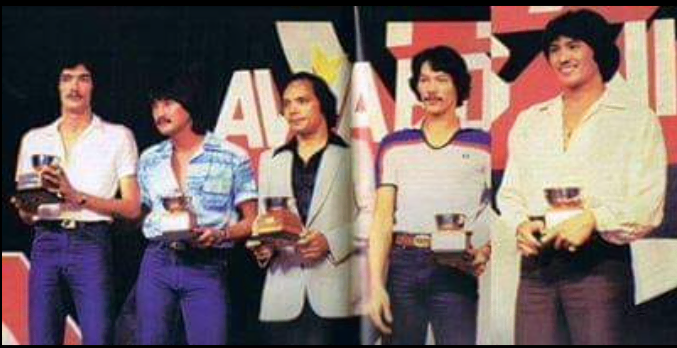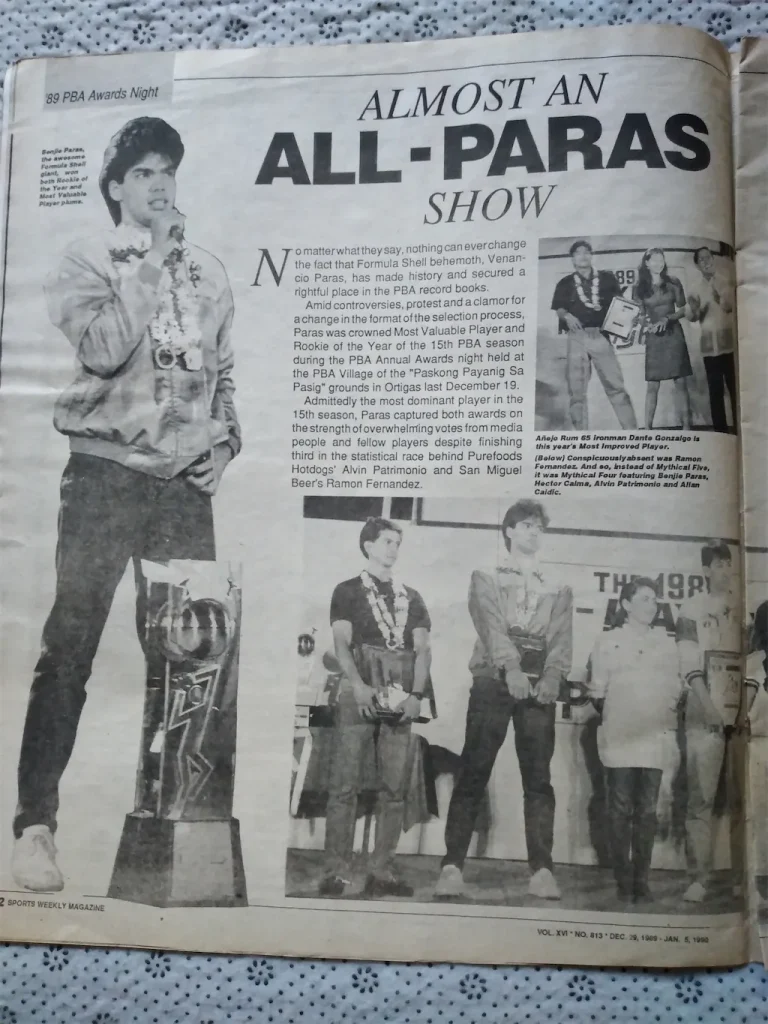The Most Valuable Player (MVP) plum is the most prized individual award in the PBA. The recognition is handed out to the best player of the season and with it comes the ultimate bragging rights of being the top performer for the year. It also earns the player an automatic seat in the PBA’s List of Greatest Players, a cash prize from the league, as well as a lucrative bonus from the player’s mother team.
While majority of the winners are undisputed, there have been some that were questioned, thereby creating unexpected controversies. The Rivalry lists down five of the most controversial MVP results since the league began in 1975.
Some notes
– The basis of the MVP selection is divided into statistics and balloting. Balloting is divided into players’ votes, media votes and the PBA. From 1977 to 1979 though, points in the All-Star games and fan votes during the All Star games were also counted.
– Cumulative statistics were used until 2006, which gave the player with the highest statistical points an edge. Starting 2006, the statistical points were averaged on a per game basis for fairness.
– From 1975 to 1979, the PBA MVP awards were given out after the All-Filipino first conference of the season. The performance of the players in the import-laden conferences (points earned in the second conference also known as the Open and the third conference – the All-Philippine or Invitationals) were not included. In 1980, the PBA started handing out season-ending awards, where the points in the second and third conferences were added.
– Bonus statistical points were given to players if their team won in the playoffs. The deeper the team reached the playoffs, the higher the bonus points for every won games.
– Statistical points came from points made, rebounds, assists, blocks, steals. Deductions were given out for turnovers made, technical fouls and flagrant fouls.
– A player can only qualify for the MVP award if he played in 70% of the total games that his team played for the entire season.
– In 2020, the PBA only had one conference, the Philippine Cup, brought about by the COVID-19 pandemic. No MVP award was given that year.

The list
Fortunato Co, Jr. over Ramon Fernandez (1979)
The first major controversy in the MVP award happened in 1979 when Crispa’s Atoy Co and Toyota’s Ramon Fernandez duked it out for the top plum. Both teams reached the finals of the All-Filipino Conference, and by that time, Fernandez was 209 points ahead of Co in the statistics category. Percentage-wise, the Toyota center was up, 69.79% to 65.36%, with only the media votes to be tabulated. It came as a total surprise therefore that on balloting night held at the Plaza Presidential Hall in Makati that of the 15 sportswriters who cast their votes, nine of them selected Co and four picked Fernandez, with one abstaining and one invalidated. Co ended up winning, 95.36% to Fernandez’s 83.12%. The late Ronnie Nathanielsz, then representing the TV coveror GTV-4, described it as “an obscene decision.” He added, “I’m ashamed to be part of the group that was instrumental in carrying out what in my view was an obscene verdict and an unmitigated act of unfairness. I wonder how those guys can sleep tonight or look at their faces in the mirror tomorrow morning.” An unnamed PBA coach went up to Fernandez after the announcement and told him, “Mon, you were robbed.” Commissioner Leo Prieto, acting on the suggestion of media, announced that the MVP selection would be reviewed and revised. The year after, the MVP award was handed out at the end of the season.
Venancio Paras, Jr. over Ramon Fernandez and Alvin Patrimonio (1989)
Fernandez could have easily won six MVP awards, except that fans felt he was “robbed twice.” In 1989, Fernandez’s team, San Miguel Beer, dominated the season with a grand slam and he was the heavy favorite to win the plum. At the end of the cumulative statistical race, Fernandez ended up second overall behind Purefoods’ Alvin Patrimonio and slightly ahead of Shell’s Benjie Paras. There were insinuations about certain players being instructed to vote a certain way to prevent Fernandez from winning, but nothing concrete was ever proven. In any case, despite finishing third in the statistical race Paras won the balloting, installing him the first and only player to date to ever win the MVP crown on his rookie year.

Renato Agustin over Nelson Asaytono (1992)
In a season that saw three different titlists (Shell, San Miguel and Swift), it was evident that the race for the MVP would be extremely tight. Agustin’s SMB won the All-Filipino title, while Asaytono’s Swift swept the 1992 Third Conference finals series against 7-Up. Asaytono topped the statistical race category with Agustin ending up second overall. Under normal circumstances, an MVP contender with an All-Filipino title would have the slight edge over his rivals who won in import-laced conferences. On the other hand, Swift won the season-ending third conference title, putting Asaytono’s name on top of mind of the fans. In the end, the Atom Bomb won MVP honors after beating the not-so-media friendly Asaytono in the voting. This was the first of several frustrated bids of Asaytono for the MVP award, making him one of the greatest ever not to have won the prestigious title.
Venancio Paras, Jr. over Sonny Alvarado, Danny Seigle and Eric Menk (1999)
Paras had a scintillating first eight years in the PBA, winning the MVP on his rookie year, was part of the First Mythical Team four times and the Second Mythical Team three times. The only year he wasn’t there was in 1993, when he sat out for one conference after a contract dispute with Shell. He was a shadow of his old self in 1997 and 1998 so it came as a major shock to see him elevate his game to elite level once more in 1999. Challenged by the influx of several Fil-foreign players who wanted to replicate his 1989 feat as rookie MVP, the Tower of Power rose like a phoenix and went head-to-head against the likes of Asi Taulava, Eric Menk, Danny Seigle, Rob Parker and Sonny Alvarado to power Shell to the All-Filipino championship against Tanduay Gold. In the MVP race, Alvarado ended up first, with Seigle and Paras finishing second and third, respectively. The stats race was tight, and it boiled down to the voting, where media validated Paras’ comeback by giving him his second MVP award, 10 years after winning his first. More than this though, Paras held the fort for the homegrown talents in what many described as the invasion of the Fil-Foreign players in the PBA.
James Yap over Kerby Raymundo and Enrico Villanueva (2005-06)
This was the year when Kerby Raymundo immortalized the line, “AKO ANG TUNAY NA MVP!” He said this after the Best Player of the Conference award went to Enrico Villanueva of Red Bull. At the end of the season, Raymundo’s Purefoods’ teammate, James Yap was ahead of the stats race, followed closely by The Kid. The former UE Warrior hotshot eventually won MVP honors. At the same time, Yap was slowly but surely becoming the face of the league alongside Ginebra rival, Mark Caguioa. But with a Philippine Cup title in his belt and the lead in the statistical race, it wasn’t totally unconvincing. While Yap and Raymundo were the primary catalysts of the Hotdogs’ successful campaign that year, Coach Ryan Gregorio turned to Yap more, especially when the chips were down, particularly during crunch time. Curiously, the PBA after this season, discarded the cumulative statistical race to avoid favoring players who played more games. In its place, the averaging system took effect the season after.
There were other slightly less controversial MVP awards that didn’t make this list. In 1975, the pioneer season, Bogs Adornado won the MVP award after topping the statistical race brought about by his league-leading 26.8 points per game. Francis Arnaiz, who averaged 19.6 points, ended up second in the statistical race. Toyota, though, won the first conference, although they were reinforced by import Byron “Snake” Jones while Crispa didn’t field an import. At the end of the year, the sportswriters’ association gave Arnaiz the Mr. Basketball award over Adornado. In 1977, Freddie Hubalde, picking up the slack from an injured Adornado, won the title over Robert Jaworski. But with Crispa winning the first conference of the season, Hubalde more than earned this distinction. In 1988, SMB’s Abet Guidaben was on his way to winning his third MVP plum but a celebrated trade between him and Fernandez stalled his progress while allowing Don Ramon to secure his fourth.
Jay Mercado is a school administrator and part-time graduate school professor who used to write for FHM Philippines and SLAM Philippines. His area of concentration is Philippine sports history.
